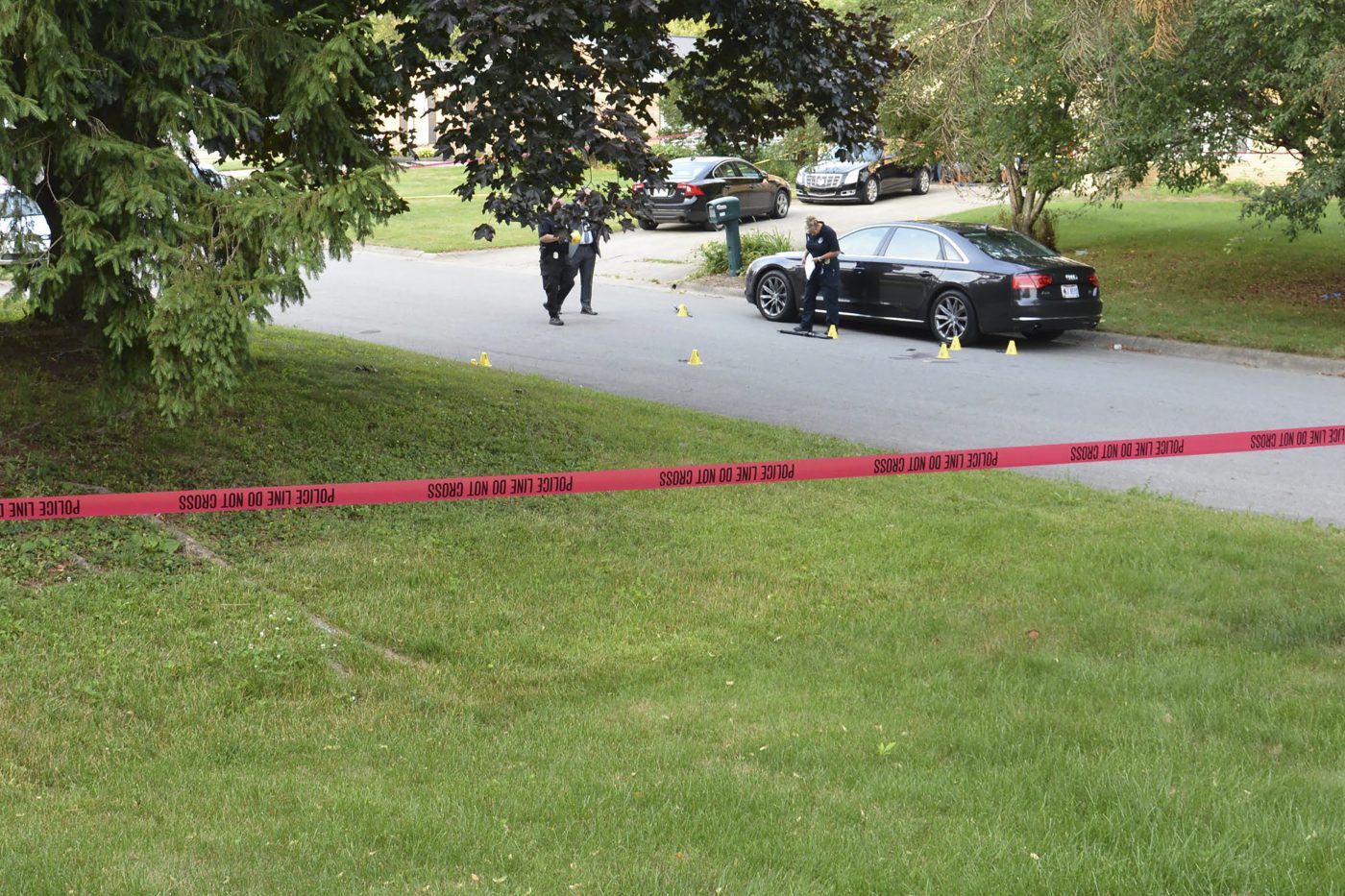
How gun violence spread across American cities
COLUMBUS, Ohio — The sequence of events that led to the killing of Jason Keys was so confounding that friends and family did not quite believe it until they saw the video evidence in court.
Keys and his wife, Charae Williams Keys, were getting into their car after a Father’s Day visit in 2021 with her grandparents in a leafy neighborhood near Walnut Hill Park in Columbus, Ohio. A 72-year-old neighbor carrying a rifle accosted them in the belief, he later told police, that Keys had let the air out of his daughter’s tires and poisoned his lawn.
Charae Williams Keys, whose late husband, Jason Keys, died after being shot several times, in Columbus, Ohio, on Feb. 15, 2024. Keys held her late husband’s wedding ring on a necklace, which she said she rarely takes off. (Sylvia Jarrus/The New York Times)
Jason Keys, who was carrying a pistol in his waistband, and his father-in-law tried to disarm the man, knocking him to the ground, while another relative ran back inside to get a .22 rifle. While Charae Keys ducked behind the car to call 911, she heard multiple gunshots. She emerged to find her husband mortally wounded.
It took a moment for everyone to realize that the shots had come from a fourth gun across the street. Elias Smith, a 24-year-old ex-Marine, had stepped to his front door with a so-called ghost gun, an AR-style rifle that Smith had assembled from parts ordered online. Within seconds, he opened fire, hitting Keys five times.
“What are you shooting for?” a relative of Keys can be heard asking on surveillance video.
Smith answered, “I don’t know.”
It was an encounter emblematic of gun violence in America today, a dispute that might not have turned deadly but for firearms in increasingly easy reach. And it exemplified a striking spread in fatal shootings nationwide since the beginning of the pandemic in 2020 — a period in which Americans have purchased more guns, the Supreme Court has made them harder to regulate, and many states, including Ohio, have loosened restrictions on firearms.
The block, on the far east side of Columbus, had been a haven, with little if any gun violence. That kind of peace was what had drawn Charae Keys’ grandparents to the area decades earlier.
And then, a burst of gunfire would take the life of Jason Keys and with it, the neighborhood’s sense of security.
Many are closer to violence
A New York Times analysis of fatal shootings across the country found that as the toll of gun violence rose during the pandemic, the carnage expanded its boundaries. Though gun violence remains highly concentrated, more than 47 million Americans lived within a five-minute walk of a fatal shooting between 2020 and 2023, up from 39 million over the prior four-year period. In Columbus, 41% of residents lived within a quarter mile of a fatal shooting, compared with 28% before the pandemic.
The same spread of gun violence seen in Columbus took place in other cities.
St. Paul Police investigators at the scene of a shooting on the 1900 block of Marshall Avenue Monday, April 1, 2024 that is being investigated as a homicide. A report of a suicide in St. Paul’s Merriam Park neighborhood turned into a homicide investigation as police said they learned more details. (Courtesy of the St. Paul Police Department)
In Atlanta, 58% of residents lived near a fatal shooting during the pandemic years, up from 36% in the four years before 2020. In Minneapolis, half of its residents were exposed, up from a third. In St. Paul, it was 36%, up from 28%.
In 2021, the number of killings in Columbus spiked to 207, unfathomable in a city where most years saw closer to 100. Last year, there were 149.
In Columbus, as elsewhere, the carnage has been marked by the involvement of conspicuously young people. Last June, two Columbus boys, 14 and 16, were charged in the shooting death of a girl in eighth grade. In August, a 13-year-old was arrested after a 15-year-old football player was killed at a shopping plaza.
Related Articles
Teen killed in three-vehicle Rochester crash that involved Minnesota State Patrol squad car
Just a drill: Training at Macalester College in St. Paul will draw emergency responders Tuesday
Violent Crime unit teaming BCA agents with local cops to focus on guns, drugs
Second man charged in Minneapolis gun battle that killed off-duty Eagan firefighter
Charges dismissed in attempted murder case outside St. Paul store
Columbus is far from alone in its troubles. In New Mexico last September, Gov. Michelle Lujan Grisham declared a state of emergency for Albuquerque after shootings claimed the lives of an 11-year-old, a 5-year-old and a woman who confronted a group of teenagers in her stolen car. Louisville, Kentucky, calculated that gun homicides were costing the city $104 million a year in law enforcement, medical care and lost tax revenue.
Even though the tide of shootings and killings that washed across the country with the pandemic began to ebb last year, the improvement was uneven. Columbus closed out 2023 with more homicides than the year before — as did Dallas; Topeka, Kansas; Memphis, Tennessee; and Washington.
There is optimism that 2024 is going to be better in Columbus, which has seen homicide numbers fall dramatically so far this year, with 36 as of last week, compared with 70 in the same period the year before. Gun violence nationwide is still higher than it was before the pandemic: The number of fatal shootings in the first quarter of 2024 was 13% higher than it was in the same period in 2019, according to the Gun Violence Archive.
In 2022, Mayor Andrew Ginther declared gun violence a public health crisis.
Gun regulations
For more than a decade, the Ohio Legislature had been scaling back gun regulations. In 2014, they rescinded a ban on high-capacity magazines.
Then, in 2019, an assailant in Dayton used one to fire 41 rounds in under 30 seconds, killing nine people and wounding 17.
The outcry that followed prompted Gov. Mike DeWine, a Republican, to promise changes that included expanded background checks and a “red flag” law allowing for the temporary removal of guns from people deemed dangerous to themselves or others. The proposals went nowhere.
Instead, in 2020 the state enacted a “stand your ground” law supported by gun rights organizations, expanding established limits on when a shooting can be deemed self-defense.
In 2022, Ohio lawmakers allowed school boards to arm teachers who completed 24 hours of training, eliminated permit and training requirements for concealed weapons, and banned cities from prohibiting gun sales during riots.
Proponents of expansive gun rights argue that increased regulation only makes it harder for lawful buyers to obtain guns for legitimate reasons, and that criminals will always find ways to skirt stricter laws.
Facing a mounting body count in 2021 and 2022, Columbus tried to test the state ban on local lawmaking. The city enacted legislation requiring guns to be safely stored around children and banning high-capacity magazines. But the measures were stalled by court challenges, one by the state attorney general, a Republican, and the other by private citizens. Columbus, in turn, has challenged the 2023 state law that prohibits cities from halting the sale of guns and ammunition during riots.
“I feel like at times we have one or two arms tied behind our back trying to fight gun violence,” said Ginther, a Democrat who just began his third term. “And it can be very frustrating because the people are angry. They want more to be done.”
The sharp decline in homicides this year is an encouraging sign, but officials say they are up against a tidal wave of guns.
In 2020, there were 11.3 million guns manufactured in the United States for domestic consumption, more than twice the number produced in 2010, according to the federal Bureau of Alcohol, Tobacco and Firearms. There are also signs that more guns are vanishing from the legal market.
Between 2017 and 2021, the percentage of guns recovered from crimes that had been purchased within the previous year steadily increased, according to ATF data. A short “time to crime” can indicate an illegal straw purchase intended to evade background checks, minimum age laws and other safeguards.
‘Ticking time bombs’
Walnut Hill Park Drive still has its broad front lawns, backyard play forts and late-model pickups parked in circular drives. But much has changed on the block since Father’s Day in 2021.
Elias Smith, the former Marine who shot Jason Keys, no longer lives in his mother’s basement — he is serving 15 years to life for murder. His trial included evidence that he had both post-traumatic stress disorder and a traumatic brain injury.
Charae Williams Keys with a photo of her with her late husband, Jason Keys. (Sylvia Jarrus/The New York Times)
Robert Thomas, the neighbor who instigated the episode with his rifle, was acquitted of an involuntary manslaughter charge but convicted of aggravated menacing. He was placed on house arrest at his daughter’s home and ordered to stay away from the block.
Charae Keys, who was wounded by shrapnel in the shooting that killed her husband, is still recovering both physically and mentally. She and her husband had both known victims of gun violence. That was one reason they lived in a high-security apartment complex, went to work, went to church and tried to “stay out of the way,” she said. It was not enough.
“Now we have people walking around who are just ticking time bombs,” Keys said. “I’ve done everything in my power to keep me from violence, but it’s chasing me.”
This article originally appeared in The New York Times.
Related Articles
Teen killed in three-vehicle Rochester crash that involved Minnesota State Patrol squad car
Just a drill: Training at Macalester College in St. Paul will draw emergency responders Tuesday
Violent Crime unit teaming BCA agents with local cops to focus on guns, drugs
Man pleads guilty to St. Paul sober house killings
Pedestrian in ‘very critical condition’ after being hit by pickup truck in West St. Paul

